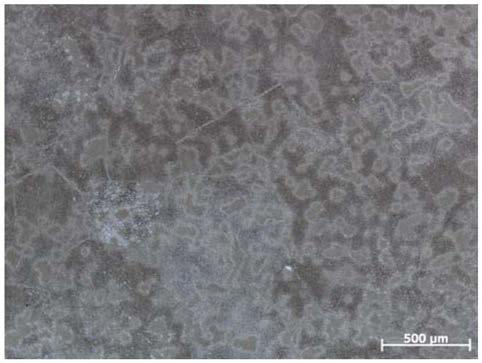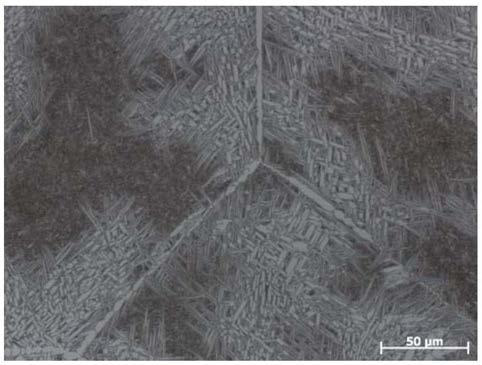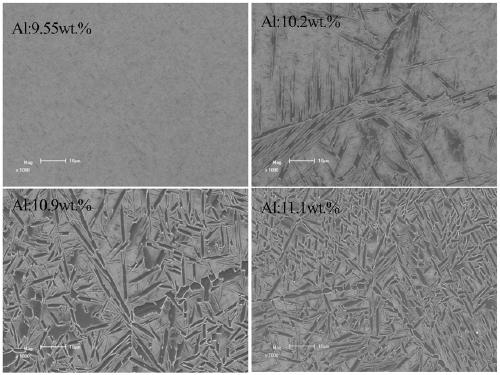As-cast strong and tough ti3al intermetallic compound and its manufacturing method and application
An intermetallic compound, strong and tough technology, applied in the field of Ti-Al intermetallic compounds, can solve the problems of high density, can not meet the requirements of high thrust-to-weight ratio engine weight reduction, etc., and achieve the effect of good high temperature mechanical properties
- Summary
- Abstract
- Description
- Claims
- Application Information
AI Technical Summary
Problems solved by technology
Method used
Image
Examples
Embodiment 1
[0045] Example 1 # ~4 #
[0046] Example 1 # ~4 # The ingredients are listed in Table 2. The smelting process of the ingot is a vacuum consumable smelting, a vacuum shell smelting, a vacuum suspension smelting, and then casting into a φ70mm casting rod in a steel mold. After the cast rod is solution heat treated, the sample is processed and the mechanical properties are tested. The heat treatment system adopted is: solid solution temperature 1020°C, solid solution time 1h, cooling rate 0.5°C / s. The microstructure of the sample under the scanning electron microscope can be seen image 3 , and the tensile results at room temperature are shown in Table 3.
[0047] Table 2: Example 1 # ~4 # alloy composition
[0048] Example
Alloy Nominal Composition (at.%)
Measured Al content (wt.%)
Measured O content (wt.%)
1 #
Ti-18.5Al-15Nb-1Mo
9.55
0.068
2 #
Ti-19.5Al-15Nb-1Mo
10.2
0.069
3 #
Ti-20.5Al-15Nb-1Mo
...
Embodiment 5
[0053] Example 5 # ~6 #
[0054] Example 5 # The nominal composition is Ti-22Al-15Nb-0.5Mo (at.%), Example 6 # The nominal composition of Ti-22Al-15Nb-1Mo (at.%). The smelting process of the ingot is two vacuum consumable smelting, one vacuum suspension smelting, and then casting into a φ70mm casting rod in a steel mold. The cast rod is first processed by hot isostatic pressing (HIP): the hot isostatic pressing pressure is 130MPa, the temperature is 1020±20°C, the time is 3 hours, and it is cooled to below 300°C with the furnace. After hot isostatic pressing, the samples were subjected to different solution heat treatments and the mechanical properties were tested. The tests are shown in Tables 4 and 5.
[0055] Table 4: Example 5 # ~6 # Room temperature tensile properties
[0056]
[0057] Table 5: Example 5 # ~6 # Tensile properties at 600°C
[0058]
[0059] From the tensile properties in Tables 4 and 5, it can be seen that when the Mo content changes from ...
Embodiment 7
[0060] Example 7 # ~10 #
[0061] Example 7 # ~10 # The measured components are listed in Table 6. In the alloy ingredients, the gradient increasing O element is based on TiO 2 The preparation process of other alloys remains unchanged. The smelting process of the ingot is a vacuum self-consumption melting, a vacuum shell melting, a vacuum suspension melting, and then casting into a φ70mm casting rod in a steel mold. After the cast rod is solution heat treated, the sample is processed and the mechanical properties are tested. The heat treatment system adopted is: solid solution temperature 1020°C, solid solution time 1h, cooling rate 0.5°C / s. The tensile results at room temperature are shown in Table 7.
[0062] Table 6: Example 7 # ~10 # alloy composition
[0063] Example
[0064] Table 7: Example 7 # ~10 # Room temperature tensile properties
[0065] Example
[0066] It can be seen from Table 7 that when the O content is between 0.068 and 0.1...
PUM
| Property | Measurement | Unit |
|---|---|---|
| density | aaaaa | aaaaa |
| thickness | aaaaa | aaaaa |
| tensile strength | aaaaa | aaaaa |
Abstract
Description
Claims
Application Information
 Login to View More
Login to View More - R&D
- Intellectual Property
- Life Sciences
- Materials
- Tech Scout
- Unparalleled Data Quality
- Higher Quality Content
- 60% Fewer Hallucinations
Browse by: Latest US Patents, China's latest patents, Technical Efficacy Thesaurus, Application Domain, Technology Topic, Popular Technical Reports.
© 2025 PatSnap. All rights reserved.Legal|Privacy policy|Modern Slavery Act Transparency Statement|Sitemap|About US| Contact US: help@patsnap.com



